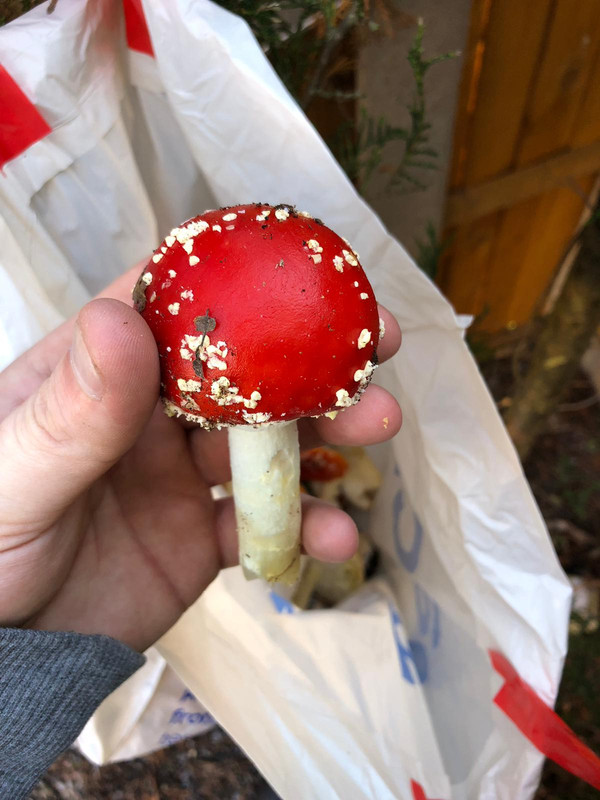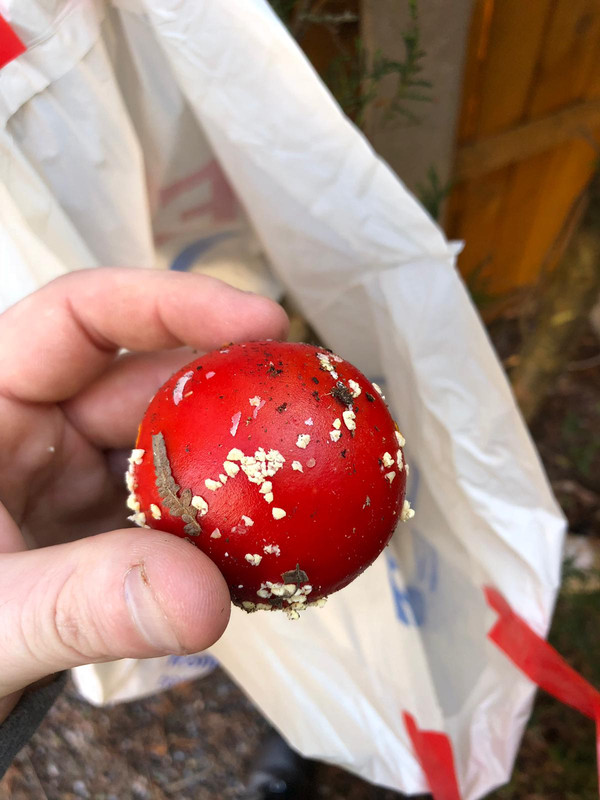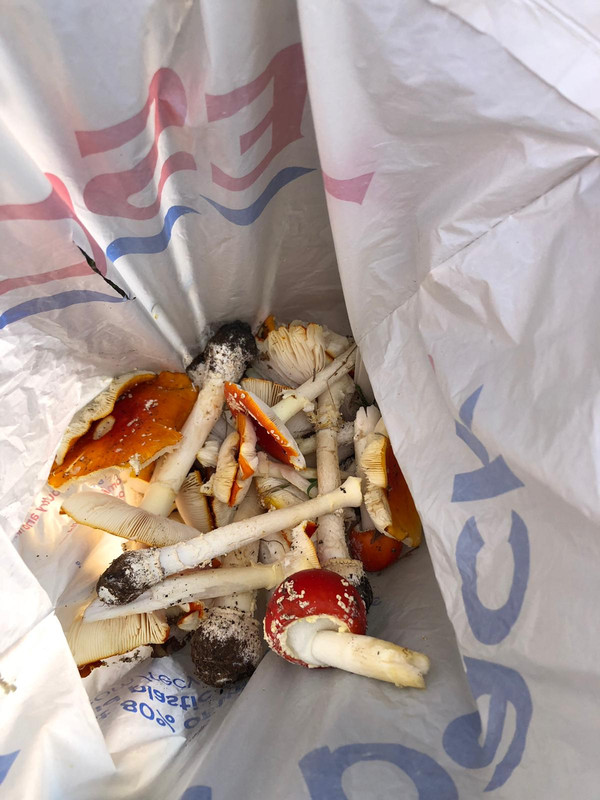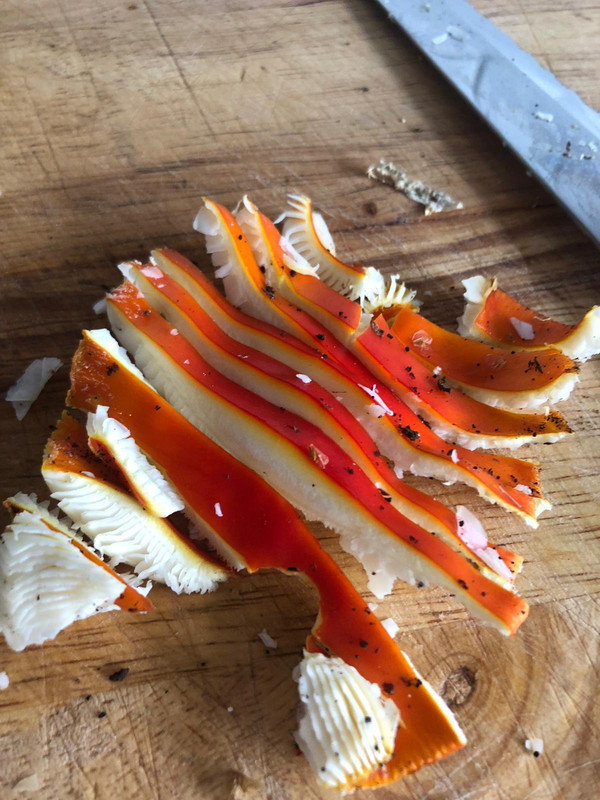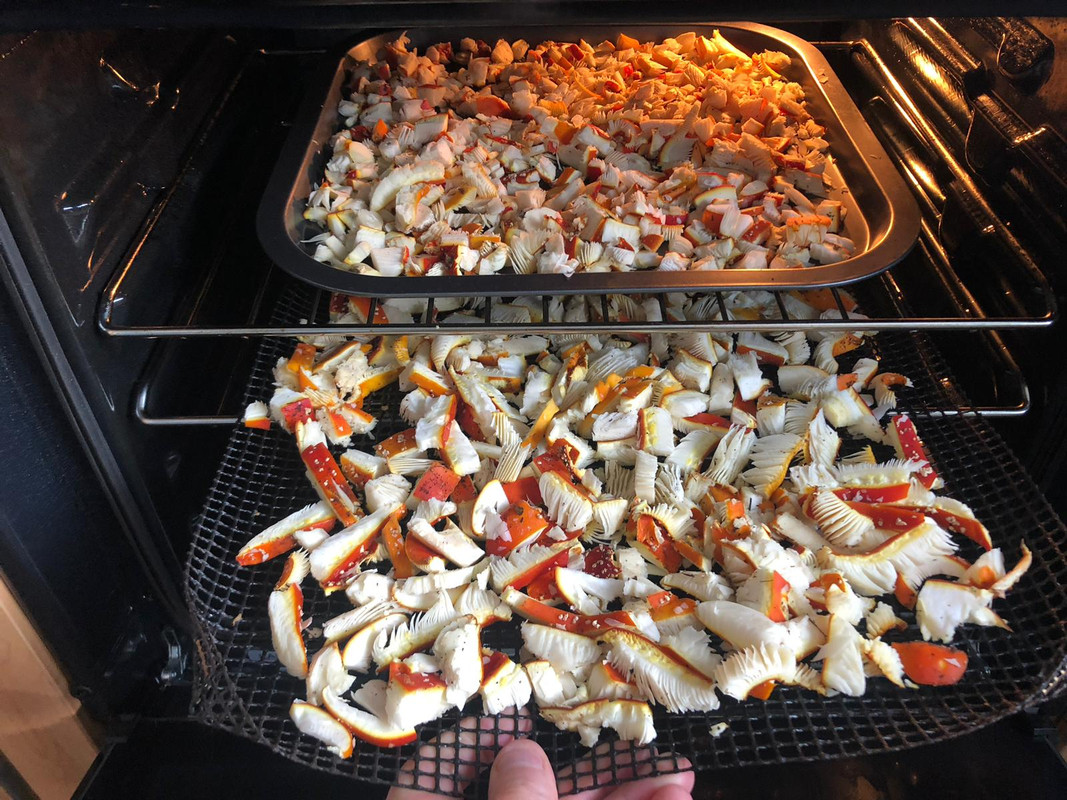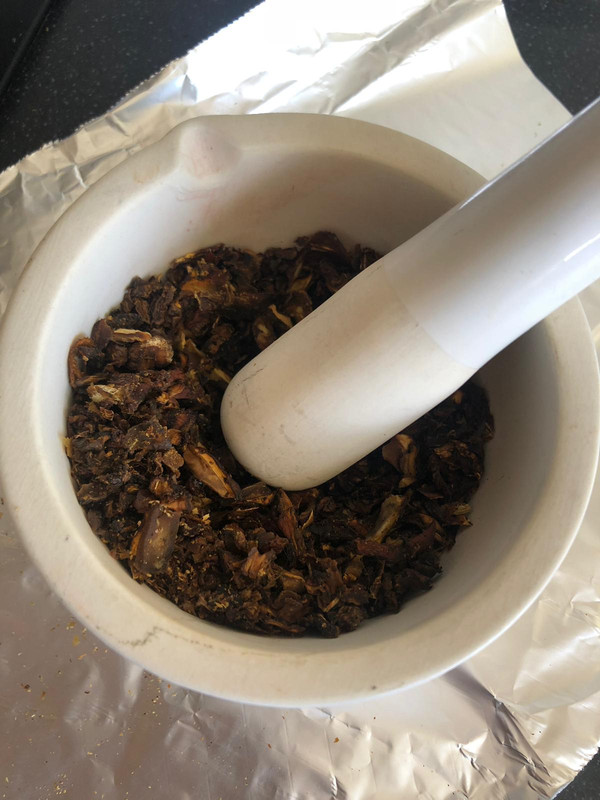Dry. You get this through your head and get it through NOW, before even thinking about taking A.muscaria.
You CAN'T just pick these and eat them fresh. You MUST cure them. The body can metabolize ibotenic acid to muscimol, but it is an excitotoxic neurotoxin, ibotenic acid, not healthy stuff, really its bad news. But thermally unstable, and decarboxylates (eliminates CO2) to form the GABAa orthosteric agonist muscimol easily. People who eat fresh fly agaric, regret it. Look at the reports on erowid and contrast those who had a good vs a shitty experience and their methods of preparation. Those who eat raw mushroom, aren't happy about it.
Also, there are a couple other isoxazole producing mushrooms within the Amanita genus, these ought to be avoided. Amanita pantherina is well known for being similar in chemistry overall, however it is a dangerous mushroom, and contains a LOT more of these isoxazoles. Also however it contains two excitatory aminoacid neurotoxins in trace quantities, stizolobic and stizolobinic acid. IIRC either AMPA or KAr agonists, which are of EXTREME potency looking at their Ki values. Only present in small quantities, but at least one of the two is active in the femtomolar range. That is absolutely astonishing, and might well make for the most potent such receptor ligands known for AMPA and/or kainate receptors. These could well be one or both of two things-if they are the orthosteric (glutamate binding site) agonists I think they are then excitotoxins, with convulsant effects and potentially permanently damaging effects by frying the hippocampus amongst other areas of the brain which in the case of the hippocampus is critical for learning and memory. Not so familiar with kainate receptors, they aren't as well known generally compared to AMPA and NMDA type ionotropic glutamate receptors. Also, it isn't impossible they may also thermally decarboxylate to give a GABAa agonist at the GABA binding site, like muscimol is. This is not an unknown relationship-that of an excitatory aminoacid excitotoxic neurotoxin which has a corresponding decarboxylated amine derivative that is an orthosteric (I.e binding the same site GABA does) GABAa agonist. Ibotenic acid is the best known such pair, with muscimol forming via thermolytic degradation of ibotenic acid on decarboxylation. Quisqualic acid is another, its an AMPA receptor agonist neurotoxin, that would cause permanent damage in an intact animal or person, or brain tissue cultures etc.. If decarboxylated, quisqualic acid forms quisqualamine, a GABAa agonist.
So, it seems like others might do the same thing, given that there is a fairly limited pharmacophore set of orthosteric GABAa agonists, although that for excitatory NMDAr/AMPAr/KAr agonist neurotoxins is wider. But it could be more common.
Still, I'd definitely avoid the panther cap at all costs. Amanita pantherina is the name, its dark brown in the color of the surface of the cap, and covered in fine white warts, contains a LOT more of the neurotoxic ibotenic acid and also muscimol the psychoactive degradation product that stems from it. IMO it is too dangerous to fuck with it.
Also, it would be wise to limit consumption of fly agaric on a frequency basis. The mushroom is a hyperaccumulator of the element vanadium, forming a complex called amavadine, that forms a deep, vivid blue cationic derivative. Not sure to the extent of which it accumulates vanadium, but some other hyperaccumulator fungi of other elements, such as Sarcosphaera, which hyperaccumulates arsenic to, in uncontaminated soil perhaps a thousand percent over other mushrooms (common would be, for arsenic, perhaps 1mg/kg dry weight of arsenic, whilst Sarcosphaera (a monotypic genus with only S.coronaria. This typically reaches 1g arsenic per kg of dry weight, and has been known to contain up to 7090mg/kg arsenic dry weight from a sample of this purple-centered cup fungus, as the toxic methylarsonic acid organoarsenic derivative. That was from a sample found in the Czech republic, and actually, holds the world record apparently for bioaccumulation of arsenic, possibly of any element in a fungus.)
So, given the potential, and status as a known hyperaccumulator of vanadium, although MUCH less toxic than arsenic, it can occur as up to 500mg/kg dry weight in A.muscaria. So, it wouldn't do, since vanadium, whilst it may well be essential in small amounts, can be toxic in larger quantities. Although it is poorly absorbed through the GI tract. Not sure how well amavadine itself is absorbed orally.
Personally I like to harvest them once the gills have freed to give them a chance to reproduce, and not take the very youngest specimens, unless its just a few now and then, if I am short, or have none, and need some to cook a meal, in which case, I'll take enough young'uns just to do a steak or two, or a spoonful of chili spice mixture (I love to use fly agaric in my kitchen, for doing beef dishes especially, especially with a parasite fungus that attacks the mycelium of A.muscaria, of the boletoid type, pored mushroom genus Chalciporus, C.piperatus, the peppery bolete, which when A.muscaria grows under silver birch (it grows also under pines at times although less often, but C.piperatus only seems to grow on the silver birch-associated mycelium), giving it a lovely way of bringing out the meaty, savoury flavours in meats, like lamb or beef, beef especially. And the peppery bolete giving it a kick. A nice little twofer really, since they come as a package deal when mushroom hunting often enough.)
But otherwise, I let them open, taking one or two for a plate of steaks is alright in my book given that they are such a common species, and if it is restricted, in the taking of immature specimens to just when one needs it for a meal to be cooked and you don't want to be watching and waiting days and hoping neither animals eat it, humans damage it, the environment does or some other bugger takes the mushrooms you were counting on for your dinner. Nothing worse than rival mushroom hunters at times lol, although at least it isn't a popular species given its listing as poisonous in all the textbooks.
It isn't nearly as bad as its made out to be in that respect. The textbooks, they are erring on the side of caution, so people don't eat a plateful, eat them raw etc. and they really don't know what they are doing in giving proper instructions as to how to use them properly. They aren't loaded with deadly poison like say, deathcaps, destroying angels and other nasty amatoxic species in the subgroup Phalloidinae within Amanita. Or the few that contain allenic norleuceine, chlorocrotylglycine etc. and other kidney damaging poisons. I simply mention the vanadium as a precaution so overindulgence is avoided. Thats quite a lot of vanadium even if its poorly absorbed orally, just present in the dried mushrooms.
Best not taken TOO old either. They can get old and soggy, and if they develop any nasty smell then that means leave it. They can do, getting a manky, soggy, wet texture and quite putrid sort of stink when way over the hill so to speak. Quite revolting in fact, makes me gorge rise, intent on rebellion against the established order, I.e of my insides remaining on the inside of me, rather than making a break for the outside. I prefer my internal organs to stay that way

Mid age is probably about right. You want them firm, of mild smell when freshly picked, fungusy is fine, thats to be expected, but no putrescence in the odor. When dried, and especially when simmering for tea, they take on a strongly savoury, yet very, very sweet, honeyed kind of odor that will, with a few caps in a pan of water simmering for tea, IMO best way to take them, they can get quite big though and still stay fresh. Depends on the individual specimen, but I've found ones the size of a small dinnerplate in diameter to be still good for harvest, when I'm out on one of my several yearly hikes to pick fly agaric to ensure I have a supply for the kitchen for the coming year until I can harvest more.
Just so long as they are good and firm. I believe its the right thing to do to let them have their chance to drop some spores, and ensure that this valuable commodity isn't ever put in danger of being lost to future generations by overzealous picking. Although I see it unlikely, it wouldn't be the first time humanity has murdered entire species of life, but they are pretty common. I want them to stay that way. And I'd be horrified to lose them altogether, since they are one of my favourite and most frequent reasons for a trip to the spice rack, and I do use a fair lot of the stuff over a year, picking a few kilograms at least if I can, wet weight, certainly enough to require being hauled back in a backpack stuffed with a bin liner bag, and/or take several trips to the woods, not that I need much convincing as to any excuse to fuck off out into the forests and start poking around in the trees and leaf litter. And especially not in one particular rather special pine forest, where I often find the pinewoods variety of A.muscaria, along with a rich, rich feast in Slippery Jack boletes, and larch boletes, both Suillus species, along with bay bolete (Xerocomus badius/syn Boletus badius) which are very tasty fried up, and given a bit of garlic butter and a squirt of lemon or lime juice, served russian style. Quite scrumptious. And best of all, lots (shopping bags full) of HUGE Lactarius deliciosus, the very, very sought after saffron milk-cap, which has been considered a delightful treat since the days of the ancient romans, who even depicted it on some of the first mosaics of mushrooms ever, and evidently, appreciated them as much as I do. (they are really tasty when roasted or grilled, such as with some mozzarella cheese over the gills as a topping, with a little salt and pepper, after a first shallow frying and then setting them to roast over a grill or hot wood coals.)
So, yeah, I'd be fucking pissed at the mycophage that extirpated Amanita muscaria as a species, not that I think it likely, I'd still be royally fucking fuming fucked off if anybody did. It is, after all, my dinner down there, that I've got to go and hike to find and pick and cure for the year to come and the next until the next growth season comes round. I think I'd probably thump the cunt to wipe out fly agarics, if I actually found out someone had and knew who was guilty of it. I'd make an intercontinental trip to do it as well, and turn up on someone's doorstep with claw-hammer in hand and an attitude adjustment to hand out ;P
As for the textbooks, generally they do say its poisonous. Mildly. And if over or misused. They just don't know what they are doing with them, if you ask me. Although severely toxic to dogs AFAIK.
And the 5g would be starting maximum, to test a batch, and dry weight, cured, since, as mentioned, it has to be.

